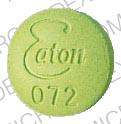Furazolidone and Alcohol/Food Interactions
There is 1 alcohol/food/lifestyle interaction with furazolidone.
Furazolidone Food/Lifestyle
Major Food Interaction
During and within two weeks after treatment with furazolidone, you must not consume any foods or beverages that are high in tyramine content. Doing so can raise your blood pressure to dangerous levels, a condition known as hypertensive crisis. The condition is potentially fatal and may cause symptoms such as severe headache, confusion, blurred vision, problems with speech or balance, nausea, vomiting, chest pain, convulsions, and sudden numbness or weakness (especially on one side of the body). You should seek immediate medical attention if you have any of these symptoms. Foods that are high in tyramine include, but are not limited to, air dried meats; aged or fermented meats; sausage or salami; pickled herring; anchovies; liver; red wine; beer; aged cheeses, including blue, brick, brie, cheddar, parmesan, romano, and swiss; sour cream; sauerkraut; canned figs; raisins; bananas or avocados (particularly if overripe); soy beans; soy sauce; tofu; miso soup; bean curd; fava beans; or yeast extracts (such as Marmite). You should avoid the use of alcohol while being treated with furazolidone, as alcohol may increase some of the nervous system side effects such as dizziness, drowsiness, and difficulty concentrating. Also avoid activities requiring mental alertness such as driving or operating hazardous machinery until you know how the medication affects you. Talk to your doctor or pharmacist if you have any questions or concerns.
Switch to professional interaction data
Furazolidone drug interactions
There are 383 drug interactions with furazolidone.
Furazolidone disease interactions
There are 3 disease interactions with furazolidone which include:
More about furazolidone
- furazolidone consumer information
- Check interactions
- Compare alternatives
- Drug class: miscellaneous antibiotics
Related treatment guides
Drug Interaction Classification
| Highly clinically significant. Avoid combinations; the risk of the interaction outweighs the benefit. | |
| Moderately clinically significant. Usually avoid combinations; use it only under special circumstances. | |
| Minimally clinically significant. Minimize risk; assess risk and consider an alternative drug, take steps to circumvent the interaction risk and/or institute a monitoring plan. | |
| No interaction information available. |
See also:
Further information
Always consult your healthcare provider to ensure the information displayed on this page applies to your personal circumstances.


